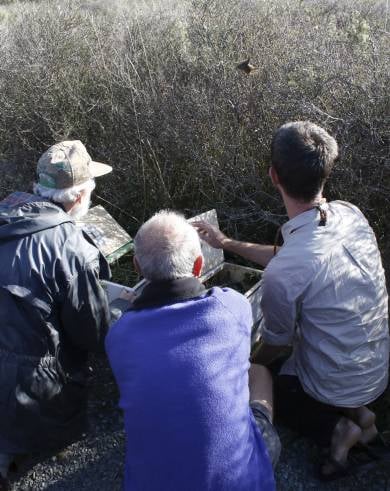Archived content: This media release was accurate on the date of publication.
Date: 20 April 2017

Members of Pauatahanui Reserve Committee release a fernbird
Image: © David Brooks | Forest & Bird
A rarely-seen bird is returning to Pauatahanui Wildlife Reserve in Porirua today, with the first of up to twenty-five birds arriving at this afternoon.
The fernbird (bowdleris punctata), or mātātā, is a small, secretive bird found in wetlands across New Zealand. However they’re at risk of extinction and have largely been absent from the lower North Island for many decades.
This re-introduction is possible thanks to volunteers from the Forest & Bird Pauatahanui Reserve Committee, who have spent the past 30 years restoring this important saltmarsh estuary, partly owned by the Department of Conservation.
“We’ve gone to all this trouble to create an estuarine environment which is a known habitat for fernbirds and it validates what we’ve achieved here if we can get fernbirds back. That’s the most pleasing thing,” said Wanda Tate, member of the Pauatahanui Reserve Committee and translocation leader.
This will be the first mainland to mainland translocation of fernbirds in New Zealand, and it’s an experiment to see if the birds will adapt to a new environment.
The volunteer group are appealing for the public’s help to make the relocation a success.
Wanda says, “So many of the fernbird populations are small and isolated. The first problem was finding a population that was strong enough to contemplate taking this number of birds from. The only population we could find was Rotokare Scenic Reserve in Taranaki, which is a bush and freshwater swamp location, not an estuarine population.
“Whether we can take from that kind of habitat and get them to recognise Pauatahanui Wildlife Reserve in Porirua as an equally valid habitat, we can’t be a hundred percent certain. It is a fairly scientific trial, rather than a given.”
The birds will be chauffeured south over the course of a week – sometimes individually, in non-stop trips, with their own driver and co-driver – because they need to be re-released to the wild as quickly as possible.
The Committee would appreciate help in tracking the birds’ dispersal around the reserve and even out into neighbouring gardens.
Wanda says, “If people do see them, try to note where and when. If people can pick up any of the banding colours that would be useful to know. Report sightings to the reserve email address – pauatahanuireservecommittee@outlook.com.
“We have restored the habitat for the birds, and will be looking after them when they arrive through our pest trapping and monitoring programme, but we need people to be aware that they’ll need time and space to settle in.”
“They’re not shy but they’re very cryptic. People may not see them – they are weak fliers and very small – smaller than a sparrow, but with a long ragged tail. If you do see them, it’s particularly important not to distract or attract them until after the first breeding season, which will be around this time next year.”
Fernbirds were originally present in Pauatahanui Wildlife Reserve.
Wanda says Captain Cook noted the fernbird was the most ubiquitous bird they saw in New Zealand so they should be here. But by the 1980’s the area had lost its mauri.”
Drainage for farming, weeds, a fire which destroyed habitat and plans to fill in the estuary for an industrial estate all contributed to the decline of these and other birds in the inlet.
Since 1984, the Pauatahanui Reserve Committee have turned things around by growing and planting thousands of natives, restoring natural drainage and ponds, and building tracks, boardwalks and bird hides with the support of DOC.
Wanda says, “That has probably had the most impact as far as the Porirua community goes; rather than just being a wildlife reserve, the reserve has become very much a community amenity.”
Background information
Habitat and distribution
Fernbirds inhabit wetlands throughout New Zealand, but are rarely seen because of their secretive behaviour and excellent camouflage. More often heard than seen, fernbirds are skulking sparrow-sized birds that are found mainly in dense, low wetland vegetation on the three main islands.
They have disappeared from large areas of New Zealand, including Wairarapa, most of Wellington and Canterbury, but remain common on the West Coast and in pockets of suitable habitat from Northland to Stewart Island.
Fernbirds have declined significantly since humans began draining wetlands and are now classed globally as at risk, declining.
Identification
Fernbirds are small (18 cm, 35 g) songbirds that are predominantly streaked brown above and pale below. Their relatively long, loosely-barbed plain brown tail feathers have a distinctive tattered appearance, and trail behind as they fly low through vegetation; this is their most distinctive feature. The mainland subspecies have a chestnut cap and a prominent pale stripe above the eye. The only other skulking passerine found in dense vegetation is the introduced dunnock, which is smaller, and has darker underparts and a shorter tail.
Fernbirds are poor fliers; they typically scramble through dense vegetation, though occasionally fly short distances with their tail hanging down, just above the vegetation.
Fernbirds are heard more often than seen due to their camouflage and the dense habitat they occupy. Their distinctive call is a characteristic ‘u-tick’ given as a duet by members of a pair. Pairs keep in contact with these duet calls.